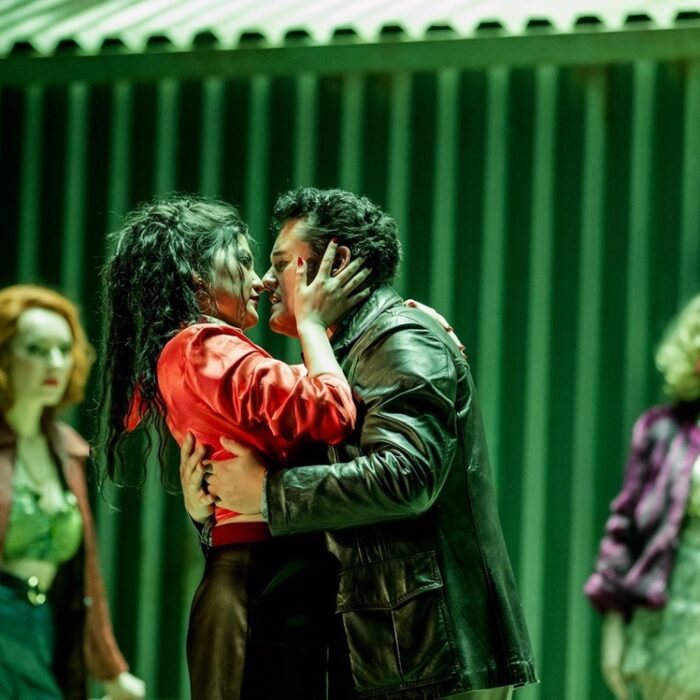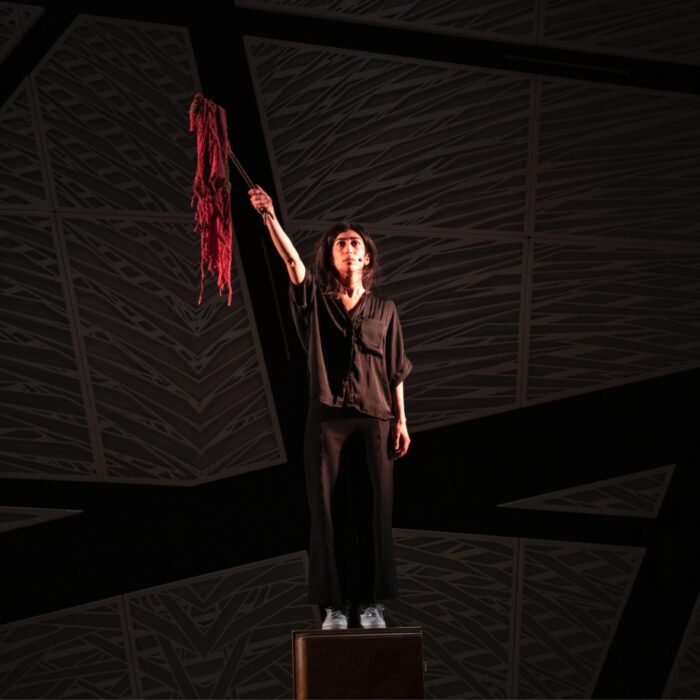
Sofia Opera & Ballet 2023 Review: Das Rheingold
By Alan Neilson(Photo: Sofia Opera & Ballet)
Bulgaria’s Sofia Opera has just premiered its new production of Wagner’s Ring cycle, its second in the last 13 years. Perhaps even more remarkable, however, is the fact that in a country with a population of less than seven million people, the cycle was cast almost entirely using home-grown talent, with only two singers coming from outside Bulgaria.
On the final evening and as the final curtain fell on its production of “Götterdämmerung,” the audience reacted with sustained and enthusiastic applause. They were cheering each of the singers, the conductor and the production team as they took their bows, and it was fully deserved. This was a production that would not be embarrassed in comparison to many major companies around the world. Having said that, it was also the case that “Götterdämmerung” was the most successful of the four operas. As with almost all productions of a full Ring cycle, it had its less than perfect moments, most notably with its performance of “Siegfried.” But, the overwhelming impression was certainly a very positive one.
Trinks Successfully Elicits A Pleasing Performance From The Orchestra
Six evenings earlier and during the prelude of “Das Rheingold, however, the initial impression was very different. The orchestral balance was poor. The heavy brass dwarfed the strings, the sound was jagged and there was little sense of the Rhine’s watery depths. Fortunately, this proved to be only temporary. Constantin Trinks, conducting the Orchestra of the Sofia Opera and Ballet, soon brought order. Or, maybe he simply calmed first-night nerves and things quickly improved.
The theatre has a relatively small pit, which meant that the orchestra was smaller than that conceived of by Wagner. The strings were notably underpowered. For example, it has only four double basses, compared to the required eight. On occasions, this both compromised the lush Wagnerian sound and allowed the brass, in particular, to overly dominate. Yet, it was also a performance with plenty of quality. There was a pleasing balance between the pit and the stage throughout the performance, even during its louder passages. The orchestra was never allowed to overwhelm the soloists. Crescendi were carefully and sensitively managed so that they emerged organically from the musical soundscape to fill the auditorium. The clearly defined dynamic contrasts were focused on supporting the drama rather than simply aiming at promoting effect. In particular, Trinks displayed particular skill in sustaining the musical arc so that each scene was musically integrated. The shape, pace, contrasts and detail were all carefully coordinated.
Kartaloff Oversees An Aesthetically Strong & Clearly Defined Staging
The director, Plamen Kartaloff, made it clear in his program notes that he was seeking to create a presentation that placed myth at its centre so as to emphasize the timeless, repetitive nature of human relations and events, in which self-interested people and societies compete for wealth and power with disastrous consequences.
Together with his team, scenographer Hans Kudlich, costume designer Hristiyana Mihaleva-Zorbalieva, lighting designer Andrej Hajdinjak and multimedia creator Ivan Liptchev, they created a reading shorn of extraneous movement, unnecessary stage props and gimmickry. This allowed the story to play out in a streamlined and clear manner, which he supported with symbolic imagery that added meaning and emotional depth. The central components of the staging consisted of three large, circular, ring-like platforms that reflected the “spiral of life” on which the singers walked. The platforms could be easily raised, lowered or tilted and were designed to be moved quickly into new positions. This allowed for rapid and fairly unobtrusive scene changes. Occasionally, other geometrically shaped scenic structures were also added, but were always carefully integrated into the sets. Kartaloff was equally attentive to the positioning of the characters on the stage so that they invariably provided the scenes with an attractive asymmetrical balance.
The back of the stage was used for Liptchev’s aesthetically pleasing video imaging, which consisted of a continuously developing montage of slow-moving and abstract images. They successfully created the appropriate atmospheres and drew the audience into the drama.
Mihaleva-Zorbalieva’s costumes generally made a favorable impression, with some of their designs hinting at Norse mythology, although often with a futuristic twist. Wotan looked authoritative and regal in his silver-grey cloak. Mime and Alberich were suitably dressed as dirty and uncivilized thugs. The giants were superbly costumed, so that they actually physically appeared to dwarf all those around them. Unfortunately, however, there were a couple mishaps. Froh and Donner looked more like superheroes from American comics than gods, and Loge’s costume did him no favors at all.
Hajdinjak’s lighting was expertly conceived to complement Liptchev’s video imaging while at the same time supporting the sets’ attractive aesthetic. His choice of lighting was often bold and imaginative. He often flooded the stage with unusual colors like bright russet brown or a sensitive pastel shade of mauve.
The overall effect was to create a series of beautifully crafted tableaux with a strong visual impact. However, it was also a presentation in which the characters were clearly defined and the narrative was easy to follow. Where it was less successful was in the development of the emotional relationships between the characters. Rarely did they allow their emotions full reign, especially in any physical sense, and when not directly involved, they hardly moved at all.
One final note of interest relating to the staging concerns is Alberich’s transformation into a serpent and then into a toad. This can be a tricky scene for a director to manage. It is rare to find both transformations carried out convincingly. In this case, the serpent was exceptionally well done. Alberich disappeared to be replaced by a long and giant serpent that coiled its way around the scenery. The toad, however, was less successful. It looked more like a puppet from a Walt Disney film.
All Bulgarian Cast Includes A Number Of Strong Performances
Over the course of the cycle, the role of Wotan was cast using three different singers. For “Das Rheingold,” the role fell to baritone Nikolay Petrov, who proved to be the weakest of the three. Although by no means a poor performance, he struggled to fully impose himself on the role. The voice lacked the necessary force, body and authority to fully convince. In his confrontations with Alberich, it was the dwarf who had the greater presence and dominated. Also, on occasions there was too much vibrato in the voice as he pushed it in an attempt to command the scene. On the positive side, Petrov was sensitive to the dramatic dimension of the character, and to an extent, his acting and postures managed to compensate. His voice has an appealing timbre and his singing, despite its shortcomings, was technically correct.
By contrast, soprano Mariana Zvetkova as Fricka, produced a strongly defined portrait of the god’s narrowly focused wife. She was full of energy, forceful and energetic in her clashes with Wotan over the fate of her sister Freia. Her fashioning of the vocal line was convincingly clothed with emotional power, peppered with strong, angry emphases that successfully brought out her anxieties and fears in what was a compelling and expressive performance.
In the opening scene, baritone Plamen Dimitrov made a strong and immediate impression with his unkempt, dirty, rough and uncivilized appearance as he forlornly chased the Rhein maidens around the stage. It was a strong characterization in which Dimitrov successfully captured the dwarf’s vicious and resentful nature. His singing was confident and expressive throughout, and his ability to furnish the vocal line with emotional depth was expertly crafted.
Tenor Daniel Ostretsov created a compelling reading of the slippery semi-god of fire, Loge. Ostretsov flitted and glided across the stage with a knowing, carefree attitude, exuding an air of superiority and superficiality. His singing lay easily on the ear yet was carefully attuned to the dramatic nuances of the scenes, employing plenty of vocal inflections and emphases while coating the voice with a blithe confidence.
Tenor Krassimir Dinev was a suitably downtrodden, self-pitying Mime. Constantly bemoaning his fate, he whined and whinged his way through the evening, while planning and hoping for a change in his fortunes. Both his acting and singing displayed quality.
Looking splendid in their costumes were basses Petar Buckov as Fafner, and Stefan Vladimirov as Fasolt. They created a strong impression as the two giants. Although acting in tandem, their characterizations were clearly differentiated to create two distinct figures. Buchkov used his wonderfully expressive and secure voice to create a forceful, vicious and determined Fafner. Vladimirov used his colorful palette to develop a plodding, almost sympathetic Fasolt.
Svetozar Rangelov, cast as the hammer-wielding god Donner, produced a strong performance in which he successfully employed his secure, resonant bass to emphasize the god’s impulsive and slow-witted nature.
Tenor Hrisimir Damyanov, in the small role of Froh, struggled to make an impression. His vocal projection was far too weak. Unless he was at the front of the stage, he was barely audible, and even then, his voice sounded small. However, it was also clear that he has a very appealing voice with a beautiful timbre.
Mezzo-soprano Silvana Pravcheva possesses an expressively vibrant and resonant voice with a fine degree of versatility, which she showed off to good effect with an emotionally compelling performance in the role of Freia.
Erda was played by mezzo-soprano Vesela Yaneva. In what was a vocally attractive performance, she caught the attention with a clearly defined, emotionally strong characterization in which her beautiful-sounding lower register impressed. On the negative side, however, it was a reading that did not fully embrace her distant and eternal nature.
The Rheinmaidens, Woglinde, Welgunde and Flosshilde, played respectively by sopranos Ayla Dobreva and Ina Kalinova and mezzo-soprano Alexandrina Stoyanova, showed great agility in singing their roles while bouncing around on trampolines, which cleverly emphasized their frivolous and playful natures. Although, it did mean that the quality of their singing was slightly compromised.
Although it was a performance with one or two weaknesses, the overall standard was very good and had much to commend it, not least the quality and beauty of the staging, which in some scenes was visually stunning. Certainly, it did enough to whet the appetite for the rest of the cycle.



